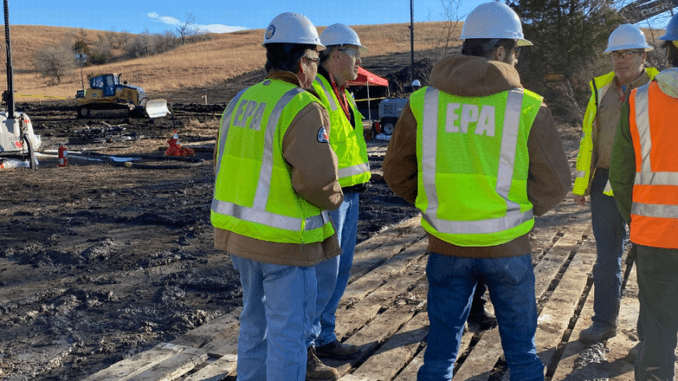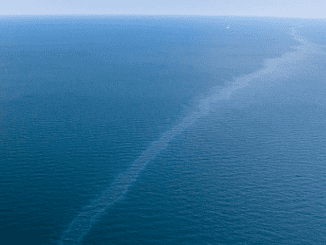
LENEXA, Kansas, January 9, 2023 (ENS) – Canada’s TC Oil Pipeline Operations Inc. has reached an agreement with the U.S. Environmental Protection Agency, EPA, to clean up the large oil spill that occurred December 7 in Washington County, Kansas, due to a rupture in the controversial Keystone crude oil pipeline near the Nebraska-Kansas border.
Although the leak is the largest in the United States since the 2013 North Dakota spill on a different pipeline and the largest-ever in the history of the Keystone Pipeline, to date, the cause of this breach is unknown.
TC temporarily shut down the 36-inch Keystone Pipeline to handle cleanup; service was restarted in late December.
TC Oil Pipeline Operations Inc. operates sections of the Keystone Pipeline System, a 2,687-mile liquid oil pipeline system between Hardisty, Alberta, Canada, and Port Arthur, Texas that carries heavy crude oil from the Alberta tar sands to refineries in Port Arthur, Texas.
On December 7, 2022, the Keystone Pipeline ruptured about 20 miles (32 km) south of a key Steele City, Nebraska junction. The breach occurred in a section of the pipeline that stretches from Steele City to Cushing, Oklahoma, which was completed in 2011.
TC Energy estimates that some 14,000 barrels of oil (588,000 gallons) of crude oil leaked from the ruptured pipeline over land and into Mill Creek, a picturesque, leafy waterway. About 740 workers were still on site as of January 5, local media reports.
No towns or cities draw their water from the immediate area, but the pipeline was carrying diluted bitumen, or dilbit, which starts sinking when it hits a stream; traditional cleanup methods for collecting floating oil don’t work on this.
The discharge “subsequently violated the federal Clean Water Act, creating an imminent and substantial threat to human health and the environment,” EPA says. Discharges of pollutants, including oil, into federally protected waterways are violations of the Clean Water Act.
In its cleanup order, finalized January 6, EPA asserts that the oil-impacted surface water in Mill Creek, for at least three and a half miles (5.6 km) downstream of the pipeline rupture, contaminated vegetation near the break, caused a visible sheen on the water, and “significantly affected fish and wildlife.”
The EPA order requires TC Oil Pipeline Operations Inc. to recover oil and oil-contaminated soil and vegetation and contain the further spread of oil in Mill Creek, working under EPA oversight.
The company says activities are ongoing to temporarily divert Mill Creek from a location upstream of the pipeline spill, to downstream of the containment dams. The diversion includes the installation of water pumps and an above-ground bypass line.
Everyone concerned appreciates the first responders. EPA Region 7 Administrator Meg McCollister said, “EPA is grateful to the hundreds of EPA and other federal, state, and local agency personnel who quickly responded to this emergency. The federal government and the state of Kansas are committed to a thorough cleanup and restoration of the impacted area.”
TC Energy said, “To demonstrate our appreciation for the Washington County emergency responders and their rapid action and support during our initial response, we are giving $7,500 toward mobile and radio equipment. This will enhance the communication and response capabilities of the Washington County emergency responders.”
TC Oil Pipeline Operations is owned by TC Energy Corporation, formerly TransCanada Corp., based in Calgary, Alberta, Canada. The Keystone oil pipeline is owned by TC Energy and . The company develops and operates pipelines and other energy infrastructure in Canada, the United States, and Mexico.
Featured image: U.S. EPA personnel speak with Pipeline and Hazardous Materials Safety Administration Accident Investigator Ky Nichols (second from right) on the scene of the TC Energy pipeline rupture response. (Photo courtesy U.S. EPA)



